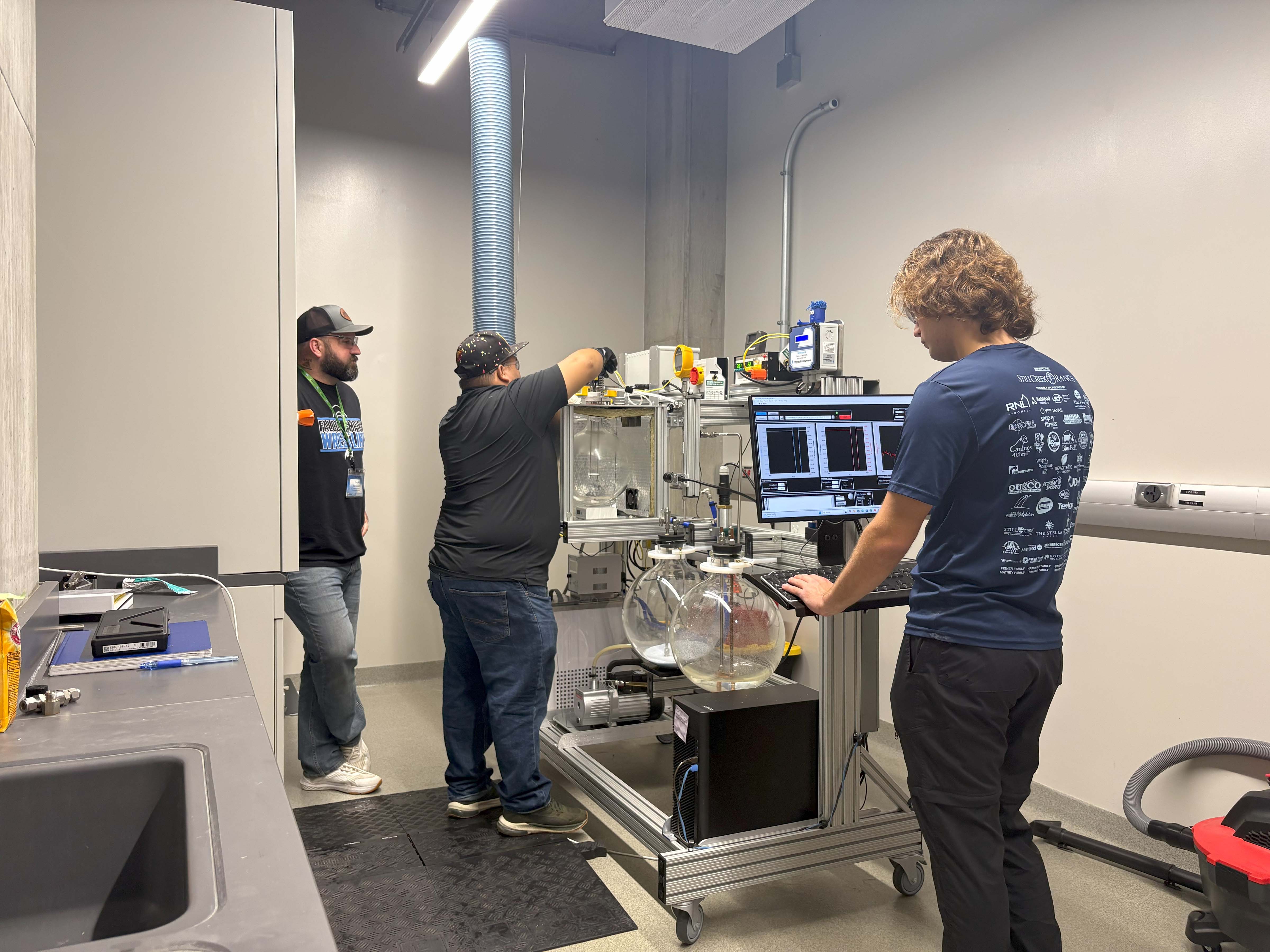“There’s a lot of math in HVAC”

Johnson County Community College professors worked at a KU engineering lab this summer to deepen their knowledge of the principles underlying heating, ventilation, air conditioning and refrigeration (HVACR)
If your AC unit goes out in the middle of the summer, you call a repair company.
The technician’s job is to fix the problem as soon as possible, so you can be comfortable. No theoretical conversation required.
But this summer, two professors from Johnson County Community College’s Heating, Ventilation and Air Conditioning Department spent a month inside a lab at the University of Kansas School of Engineering, where they deepened their knowledge of refrigerants, the chemicals working inside AC units to keep people cool.
“As HVAC educators, we often don't get to see the science behind much of what we work on,” said Mike Steinmetz, a full-time professor and outgoing chair of the HVAC Department at JCCC, which is located in Overland Park, KS. “Being able to test, determine, and understand the low-flammability and high-flammability levels of refrigerants will be an asset to my students and our program going forward.”
Steinmetz and his colleague Jhonatan Vallejo, the incoming chair of the HVAC program at JCCC, joined KU faculty and students as part of a Research Experiences for Teachers program.
The RET was made possible by EARTH, the Environmentally Applied Refrigerant Technology Hub, an engineering research center funded by the National Science Foundation. EARTH’s mission is to modernize the HVACR industry.
EARTH is led by KU and also involves professors, staff and students from the University of Notre Dame, Lehigh University, University of Maryland, University of Hawai’i, and University of South Dakota. Through EARTH’s industry consortium members, the center also receives financial support from U.S. companies seeking to accelerate the development and commercialization of innovative HVACR technologies, including next-generation refrigerants and advanced cooling systems.
Steinmetz and Vallejo tested various ratios of refrigerant to air and assessed the conditions under which the cooling agent could pose a hazard. They followed standards set by ASHRAE, the American Society of Heating, Refrigeration and Air-Conditioning Engineers, one of many professional trade associations partnering with EARTH.
“Our goal was to find collaborative and correlative data,” Vallejo said. “We teach the trades to people who may go on to have their own businesses. And they will be repairing systems and selling refrigerants. They need to know how safe it is.”
Because sometimes, chemicals ignite.
While inherently safe, air conditioning units could be a fire hazard depending on the amount of refrigerant present, age of the unit, and if it is stored in a tight space. Modern AC systems have fire-prevention sensors that will turn off the unit if refrigerant leaks; the sensors will also turn on ventilation to lower the refrigerant-to-air ratio, Steinmetz said.
Video: In a controlled experiment, a cooling agent bursts into flames
The KU-JCCC team used a camera capturing 20 frames per second to measure the flammability of refrigerants. In this video, they are testing a mixture of 26.6% R32 (one type of refrigerant) and 73.4% air. If the flame creates an angle of 90 degrees or more, as is happening here, the refrigerant is considered flammable.
Better than geometry on a white board
Steinmetz and Vallejo also researched the Common Core national math standards and the national Next Generation Science Standards, which they cross-referenced with their college’s HVACR curriculum. They identified 34 math and 28 science concepts that can be visually explained using tools of the trade. As many students learn by doing – by seeing geometry at work on an actual machine, for example – the men’s research stands to benefit an entire generation of youth in the Kansas City region.
“Jhonatan and I frequently visit K-12 schools, demonstrating practical applications of math and science to engage students as young as fifth grade,” Steinmetz said. “Many do not realize that HVACR is math heavy.”
EARTH Education Director Casey Williams, Ph.D., M.Ed, who is based at KU, said he is speaking with fellow educators to build on Steinmetz’s and Vallejo’s initiative: He hopes to build a national movement whereby K-12 schools and community colleges across the country work together to encourage young people to pursue a career in the skilled trades.
“The K-12 system does not speak the same language as the trades – guidance counselors usually push a four-year degree,” Williams said. “But if community college professors can see the connections between HVACR, or any of the other trades, with the K-12 curriculum, then they’ll be able to excite students, parents, educators and administrators about a variety of career paths.”
Williams said the HVACR career pathway is unique because it is so multifaceted. “They have to do everything – construction, plumbing, metal work, pipefitting, ductwork,” he said. “There is so much math and physics involved, so many ways to incorporate the national standards.”
Meanwhile, Steinmetz and Vallejo will continue their outreach to more than 20 schools in and around Kansas City. “We’re eager to share what we learned this summer,” Vallejo said. “We want to build a larger pipeline of highly skilled HVACR professionals to meet the needs of Kansas employers.”